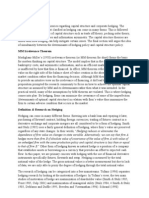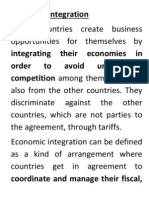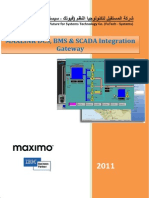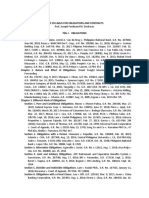An Empirical Investigation of The Trade-Off and Pecking Order Hypotheses On Romanian Market
An Empirical Investigation of The Trade-Off and Pecking Order Hypotheses On Romanian Market
Uploaded by
Bikram BisaradCopyright:
Available Formats
An Empirical Investigation of The Trade-Off and Pecking Order Hypotheses On Romanian Market
An Empirical Investigation of The Trade-Off and Pecking Order Hypotheses On Romanian Market
Uploaded by
Bikram BisaradOriginal Title
Copyright
Available Formats
Share this document
Did you find this document useful?
Is this content inappropriate?
Copyright:
Available Formats
An Empirical Investigation of The Trade-Off and Pecking Order Hypotheses On Romanian Market
An Empirical Investigation of The Trade-Off and Pecking Order Hypotheses On Romanian Market
Uploaded by
Bikram BisaradCopyright:
Available Formats
AN EMPIRICAL INVESTIGATION OF THE TRADE-OFF AND PECKING ORDER HYPOTHESES ON ROMANIAN MARKET
Abstract: Starting with the seminal work of Modigliani and Miller (1958, 1963), a growing attention has been given to the manner in which firms adjust their capital structure. When firms adjust their capital structure, they tend to move toward a target debt ratio which is consistent with trade-off theory. According to the trade-off hypothesis profitable firms should have a high level of debt ratio. Contrary to the trade-off hypothesis, the pecking order theory based on information asymmetry predicts a negative correlation be-tween profitability and leverage. We test the aforementioned hypotheses on a sample of non- financial Romanian firms, listed on the Bucharest Stock Exchange from 2005 to 2007. Using a panel data analysis, we found that pecking order theory could be successfully applied to the Romanian market. As the pecking order theory predicts, the Romanian profitable firms with a high proportion of tangible assets have a lower debt ratio.
1. Introduction
In the finance literature there are two main capital structure theories which emerged from reflections on Modigliani and Miller (1958) theorem. Firstly, trade-off theory states that firms select optimal capital structures by trading off various benefits of debt financing against financial distress costs (Kraus & Litzenberger, 1973). The benefits of debt include, for example, the tax deductibility of interest and the reduction of free cash flow problems, while the financial distress costs refer to the costs of bankruptcy or reorganisation, and also to the agency costs that arise because of conflicts between stockholders and bondholders.
Secondly, Myers (1984) developed an alternative theory known as the pecking order theory. This theory is focused on asymmetric information costs and transaction costs associated with new stock issues. Because of these two aforementioned costs, firms finance new investments first with retained earnings, then with safe debt, then with risky debt and finally with equity.
Based on these assumptions, various researchers proposed theoretical models (Jensen and Meckling, 1976; Myers, 1977; DeAngelo and Masulis, 1980; Rajan and Zingales, 1995) in order to explain capital structure decisions across companies and countries and provided empirical support to the application of the models in the real economic world. However, the empirical evidence, especially for European countries, could not keep up with the pace of theoretical developments because of the insufficient data for non-US enterprises and the lack of appropriate econometric methods (Drobetz and Wanzenried, 2006).
We test the prediction of the trade-off theory which state that the large, safe and profitable firms with tangible assets tend to borrow more than small, risky firms with mostly intangible assets and the prediction of the pecking order theory about the negative correlation between leverage and profitability. Our purpose is to determine whether capital structure determinants for Romanian firms support one of the theories of capital structure.
The remainder of the paper is organized as follows. Section 2 summarizes the predictions of trade-off and pecking order theories. Sections 3 and 4 present the variables of the designed model, the data used in order to test the model and the empirical results. Section 5 presents the conclusions of this study.
2. Capital structure theories
Our approach of the trade- off and pecking order theories largely focuses on the determinants of capital structure, more specifically on predictions of how leverage varies with these determinants.
2.1. The trade-off theory
The trade-off theory predicts that firms maintain a target debt-equity ratio that maximizes firm value. The earliest version of this theory was elaborated by Kraus and Litzenberger (1973) and states that the optimal debt-equity ratio balances the corporate tax advantages of debt against the cost disadvantages of bankruptcy. According to Myers (1984), a firm that follows the trade-off theory sets a target debt ratio and then gradually moves towards target. The target debt ratio is determined by balancing debt tax shields against costs of bankruptcy.
The agency models are based on the assumptions of the trade-off theory. According to agency models of Jensen and Meckling (1976) and Jensen (1976), the interests of managers are not aligned with those of security holders, and managers tend to waste free cash flow on perquisites and bad investments. In order to control the agency costs created by free cash flow, firms with more profitable assets in place use a large fraction of their earnings to debt payments. Thus, controlling for investment opportunities, the leverage is positively related to profitability. The underinvestment and asset substitution problems, which arise when debt is risky and the stockholder-bondholder agency problem exists, lead to the prediction that firms with more investments have less leverage (Jensen and Meckling, 1976; Myers, 1977).
In conclusion, the trade-off theory of optimal capital structure has strong commonsense appeal (Myers, 2001). It predicts that large firms with tangible assets tend to borrow more than small, risky firms with mostly intangible assets, and firms with more profitable assets in place, fewer investments, less volatile earnings and net cash-flow have higher leverage.
2.2. Pecking order theory
The pecking order theory of Myers and Majluf (1984) and Myers (1984) is based on the assumption that a firm having assets-in-place and a growth opportunity requires additional equity financing. Myers and Majluf (1984) assumed that a firm is undervalued because managers have, but cannot reveal, information concerning new and existing investment opportunities. Investors are aware of this asymmetric information problem, and they discount the firm's new and existing risky securities when stock issues are announced. On the other side, managers avoid issuing undervalued securities by financing projects with retained earnings and with low -risk debt.
Myers (1984) suggested that the costs of issuing risky debt or equity overwhelm the forces that determine optimal leverage in the trade-off model. The result is the pecking order model, which states that firms finance investments first with retained earnings, then with safe debt, then with risky debt, and finally, with equity. According to pecking order theory, more profitable firms borrow less, because they have more internal financing available and the less profitable firms require external financing, and consequently accumulate debt. 2.3. Testing the pecking order theory vs. the trade-off theory
Some authors found instructive to compare the time-series predictions of the pecking-order and trade-off theories (Shyam-Sunder and Myers, 1999; Hovakimian, Opler and Titman, 2001; Fama and French, 2002).
Shyam-Sunder and Myers (1999) tested the predictions of these two aforementioned theories on a panel of 157 firms from 1971 to 1989. They found that the pecking order theory offers the best explanation of the financing behaviour of the firms in their sample. The authors also established that the target debt ratio, if exists, is followed only by a few managers. Using a large sample of firms from 1979 to 1997, Hovakimian, Opler and Titman (2001) found references for the validity of the trade-off theory because the financing behaviour of the firms included in the sample demonstrates the existence of a target capital structure. The results show that profitable firms have a lower leverage than less profitable firms. In addition, these authors found that the pecking order theory can also explain the short-term financing behaviour of firms.
AN EMPIRICAL INVESTIGATION OF THE TRADE-OFF AND PECKING ORDER HYPOTHESES ON ROMANIAN MARKET
The empirical study of Fama and French (2002) realized on a large panel of firms from 1965 to 1999 reveals support for both theories, but these run also into serious difficulties. Thus, the trade-off theory fails to explain the significant negative correlation between profitability and leverage, while the pecking order fails to explain the heavy reliance on equity issues by small growth firms. The authors found that the pecking order theory works best for dividend-paying firms, which tend to be larger and more conservatively financed.
3. Variables of the model 3.1. The dependent variable
The main differences among leverage proxies concern the use of book values versus market values and total debt versus only long term debt. Because of data limitations, we use the book values rather than market values. Also, because most of the existing studies focus on a single measure of leverage and the
most common measure of debt is total debt, we define the financial leverage D as the ratio between the book value of total debt and the book value of total debt plus the book value of shareholder's equity (Rajan and Zingales, 1995; De Miguel and Pindado, 2001; Nivorozhkin, 2005).
3.2. The explanatory variables
We select the explanatory variables which affect the target leverage of firms based on the assumptions of trade-off and pecking order theories of capital structure and on previous empirical work in this area.
The first explanatory variable is tangibility (TANG) calculated as the ratio between tangible fixed assets and total assets (
TanA
). Tangible assets serve as collateral and the importance of collateral is greater
TA
for newly established businesses with no close ties to creditors. This hypothesis suggests a positive relationship between tangibility and leverage. Indeed, the results for developed countries (Rajan and Zingales, 1995; Titman and Wessels, 1988) confirm this hypothesis. In transitions economies, the importance of tangible assets as collateral is limited by a number of factors (underdeveloped and inefficient legal systems, illiquid secondary market) and a negative relationship between leverage and tangibility has been found in some previous studies (Cornelli et al., 1998; Nivorozhkin, 2002). Based on the aforementioned arguments, we expect to find a negative relationship between leverage and tangibility.
Another determinant of optimal capital structure used in many studies (Titman &Wessels, 1988; Rajan & Zingales, 1995; Nivorozhkin, 2005) is the firm's size. Large firms are more likely to be debt-financed in comparison with smaller firms and that is because of several reasons. One of the reasons is mentioned by Rajan and Zingales (1995) who suggested that larger companies tend to be more diversified and, thus, less prone to bankruptcy. Another reason is stipulated by the pecking order hypothesis which states that larger firms exhibit lower information asymmetry with financial markets and therefore they are able to issue more equity compared to small companies. The positive relationship between the size of a firm and its leverage may be reinforced in transition economies. Larger companies may get a favourable treatment from the creditors and there is also some evidence that banks in most of the transition countries prefer to deal with larger clients. In Romania, the firm size (SIZE) can be measured either through the number of employees or through net sales. Because the net sales are a more appropriate proxy for our goal, we use the natural logarithm of net sales (ln (NS)) and predict a positive relationship between size and debt targets. The theories of capital structure state that market imperfections lead to the relevance of a firm's profitability (PROF) for its choice of leverage. The pecking order theory predicts that more profitable firms will have a lower debt ratio. In contrast to the pecking order theory, the static trade-off theory predicts a positive relationship between leverage and profitability, because higher profitability implies more income to shield. Following Rajan and Zingales (1995) and Nivorozhkin (2005) method, we use the ratio of earnings before interest and taxes to total assets (
EBIT
) for company profitability and expect to
TA
find a negative relationship between leverage and profitability.
Myers (1977) observed that high growth firms may hold more options for future investments than low growth firms. This statement is congruent with the pecking order theory, which argues that high growth firms should use less debt for financing. Furthermore, according to the trade-off theory, firms with great growth opportunities (GROW) tend to borrow less than firms holding more tangible assets, because
growth opportunities cannot serve as tangible assets. Similar to other studies (e.g. Barclay and Smith, 1995; Rajan and Zingales, 1995), we define this proxy as the ratio of book value of total assets minus the book value of equity plus the market value of equity to the book value of total assets.
5. Conclusions
In this paper, we examined the trade-off and pecking order hypotheses using a sample of 31 Romanian listed companies. According to trade-off theory, large firms with tangible assets tend to borrow more than small, risky firms with mostly intangible assets, and firms with more profitable assets in place, fewer investments, less volatile earnings and net cash-flow have higher leverage. The pecking order hypothesis predicts a negative correlation between leverage and profitability of the firms. The empirical findings suggest that there is a difference between capital structure choices for companies in Romania and in developed countries. The negative relationship between leverage and tangibility might be explained by the lack of long -term debt financing and contradicts the predictions of the trade-off theory. More profitable companies had less debt, because these firms use, first of all, internally generated funds and debt as last resort. This result is compatible with the pecking order theory and contradicts the trade-off theory. The relationship between leverage and company size is a positive one and provides some indication about the credit policy in Romania. Thus, banks give more credits to the large firms, because these are more credible. The coefficient for growth opportunities is not statistically significant, which means that either the proxy of this factor was not appropriate or this determinant does not influence the capital structure of the sample of Romanian firms.
Therefore, we can conclude that the pecking order theory is more appropriate to explain the financial decisions of the Romanian floating firms compared to trade-off theory.
114
You might also like
- Dubai Mobile BillDocument3 pagesDubai Mobile Billshahid2opu0% (1)
- Fama & French 2005 Financing-Decisions - Who-Issues-StockDocument24 pagesFama & French 2005 Financing-Decisions - Who-Issues-StockYina Shirley Sanchez EspinosaNo ratings yet
- Philosophy of BusinessDocument9 pagesPhilosophy of BusinessIguodala Owie100% (1)
- ProductionDocument6 pagesProductionEmmanuel George100% (2)
- 2013-14 - Agha Jahanzeb - Trade-Off Theory, Pecking Order Theory and Market Timing Theory A Comprehensive Review of Capital Structure Theories-94Document8 pages2013-14 - Agha Jahanzeb - Trade-Off Theory, Pecking Order Theory and Market Timing Theory A Comprehensive Review of Capital Structure Theories-94Nicol Escobar HerreraNo ratings yet
- Capital Structure Determinants-ArticleDocument15 pagesCapital Structure Determinants-ArticlePrashant SharmaNo ratings yet
- Trade-Off Theory, Pecking Order Theory and Market Timing Theory A Comprehensive Review of Capital Structure Theories-94 PDFDocument8 pagesTrade-Off Theory, Pecking Order Theory and Market Timing Theory A Comprehensive Review of Capital Structure Theories-94 PDFYee Sook YingNo ratings yet
- Review of Capital Structure Theories TheDocument36 pagesReview of Capital Structure Theories TheFahimNo ratings yet
- Determinants of Capital Structure: A Case Study of Listed Companies of NepalDocument13 pagesDeterminants of Capital Structure: A Case Study of Listed Companies of NepalAjinkya DalviNo ratings yet
- A Critical Review of Capital Structure TheoriesDocument5 pagesA Critical Review of Capital Structure TheoriesIdd Mic-dadyNo ratings yet
- Capital Structure Management in Nepalese Enterprises: Dinesh Prasad GajurelDocument73 pagesCapital Structure Management in Nepalese Enterprises: Dinesh Prasad GajurelRussell PeterNo ratings yet
- The Effect of Leverage On Firm Value and How The Firm Financial Quality Influence On This EffectDocument25 pagesThe Effect of Leverage On Firm Value and How The Firm Financial Quality Influence On This EffectadtyshkhrNo ratings yet
- 35 NguyenManhHiep NguyenThuHang ExternalFinancing 3 PDFDocument14 pages35 NguyenManhHiep NguyenThuHang ExternalFinancing 3 PDFOng KhongthayNo ratings yet
- Capital Structure and Firm ValueDocument9 pagesCapital Structure and Firm ValueAbid HussainNo ratings yet
- In Search of Conclusive Evidence On The Trade Off and Pecking Order Theories of Capital Structure Evidence From The Johannesburg Stock ExchangeDocument17 pagesIn Search of Conclusive Evidence On The Trade Off and Pecking Order Theories of Capital Structure Evidence From The Johannesburg Stock ExchangeCorolla SedanNo ratings yet
- Determinants of The Capital Structure: Empirical Study From The Korean MarketDocument10 pagesDeterminants of The Capital Structure: Empirical Study From The Korean MarketSigit Anaklostime Stenby SellaluNo ratings yet
- Irjfe 31 07Document10 pagesIrjfe 31 07Brigitta SororityLifeNo ratings yet
- Tests of The Pecking Order Theory and The Static Tradeoff Theory of Optimal Capital StructureDocument33 pagesTests of The Pecking Order Theory and The Static Tradeoff Theory of Optimal Capital StructureRohit BaliyanNo ratings yet
- Capital Structure TheoriesDocument8 pagesCapital Structure Theoriesmuhammadbalti1122No ratings yet
- A Brief Review of Capital Structure TheoriesDocument6 pagesA Brief Review of Capital Structure TheoriesMuhammad Irfan SarwarNo ratings yet
- New Microsoft Office Word DocumentDocument6 pagesNew Microsoft Office Word DocumentĐức TùngNo ratings yet
- Panel Threshold Effect Analysis Between Capital Structure and Operating Efficiency of Chinese Listed CompaniesDocument17 pagesPanel Threshold Effect Analysis Between Capital Structure and Operating Efficiency of Chinese Listed Companiesakita_1610No ratings yet
- ProposalDocument36 pagesProposalijokostar50% (2)
- Chapter 2Document4 pagesChapter 2ganstNo ratings yet
- Capital Structure Signaling Theory: Evidence From The Greek Stock ExchangeDocument22 pagesCapital Structure Signaling Theory: Evidence From The Greek Stock ExchangeJhayan LunaNo ratings yet
- Pecking Order TheoryDocument4 pagesPecking Order TheoryThunder CatNo ratings yet
- Latest Capital Structure ManagementDocument91 pagesLatest Capital Structure ManagementSovit SubediNo ratings yet
- Determinants of Cash HoldingsDocument26 pagesDeterminants of Cash Holdingspoushal100% (1)
- How Important Is Capital Structure Policy To Firm SurvivalDocument21 pagesHow Important Is Capital Structure Policy To Firm Survivalcafe0sugarNo ratings yet
- CS Sai Ram India VijayDocument9 pagesCS Sai Ram India VijayAnonymous OM7xCjyYxNo ratings yet
- Determinants of Capital Structure: Evidence From Pakistani Firm'sDocument13 pagesDeterminants of Capital Structure: Evidence From Pakistani Firm'sSyed Ali Danish BukhariNo ratings yet
- Mac A.B CiaranDocument20 pagesMac A.B Ciarannira_110No ratings yet
- Capital Structure TheoriesDocument3 pagesCapital Structure TheoriesMalik Usman AhmadNo ratings yet
- Capital Structure TheoriesDocument8 pagesCapital Structure TheoriesLinet OrigiNo ratings yet
- Manage-Impact of Debts On The Capital Structure Pattern-Anju BalaDocument8 pagesManage-Impact of Debts On The Capital Structure Pattern-Anju BalaImpact JournalsNo ratings yet
- A Review of Capital Structure TheoriesDocument6 pagesA Review of Capital Structure Theorieswanjikukibui4No ratings yet
- Capital StrucutreDocument13 pagesCapital StrucutreAamer ShahzadNo ratings yet
- Abu Sayeed-FINALDocument16 pagesAbu Sayeed-FINALhaider_shah882267No ratings yet
- 2017 Q4 PredatorDocument14 pages2017 Q4 PredatorNurokta zilaNo ratings yet
- Capital Structure Profitability and Market Structure Evidence From MalaysiaDocument14 pagesCapital Structure Profitability and Market Structure Evidence From MalaysiaAliceNo ratings yet
- Determinants of Corporate Capital Structure Under Different Debt Maturities (2011)Document8 pagesDeterminants of Corporate Capital Structure Under Different Debt Maturities (2011)Lê DiệuNo ratings yet
- Media_199411_smxxDocument46 pagesMedia_199411_smxxMuhammad MubashirNo ratings yet
- Int Rev Finance - 2011 - BESSLER - Information Asymmetry and Financing DecisionsDocument32 pagesInt Rev Finance - 2011 - BESSLER - Information Asymmetry and Financing DecisionsRizwana HameedNo ratings yet
- ProposalDocument8 pagesProposalghaz001No ratings yet
- Factors Affecting Capital StractutreDocument15 pagesFactors Affecting Capital Stractutrejecoxol388No ratings yet
- Determinants of Capital Structure in TanzaniaDocument34 pagesDeterminants of Capital Structure in TanzaniaNtogwa Bundala100% (2)
- Corporate Finance Course Code: MBA3110-L: College of Technology LondonDocument6 pagesCorporate Finance Course Code: MBA3110-L: College of Technology Londonvarsha8878No ratings yet
- By Suleiman, Hamisu Kargi Phd/Admin/11934/2008-2009Document26 pagesBy Suleiman, Hamisu Kargi Phd/Admin/11934/2008-2009Lareb ShaikhNo ratings yet
- Determinants of Capital Structure: A Case For The Pakistani Cement Industry Syed Tahir Hijazi Yasir Bin TariqDocument22 pagesDeterminants of Capital Structure: A Case For The Pakistani Cement Industry Syed Tahir Hijazi Yasir Bin TariqToujoursBelleNo ratings yet
- Determinants of Capital Structure: A Case Study of Automobile Manufacturing Companies Listed in NseDocument7 pagesDeterminants of Capital Structure: A Case Study of Automobile Manufacturing Companies Listed in Nsebeemagani9No ratings yet
- Capital Structure and Financing Decision - Evidence From The Four Asian Tigers and JapanDocument14 pagesCapital Structure and Financing Decision - Evidence From The Four Asian Tigers and Japansitti yunisyahNo ratings yet
- Research Papers in Management StudiesDocument91 pagesResearch Papers in Management StudiesSaurabh MehtaNo ratings yet
- Optimal Capital Structure and Financial StabilityDocument22 pagesOptimal Capital Structure and Financial StabilityElvas mhoneNo ratings yet
- Hovakimian-DebtEquityChoice-2001Document25 pagesHovakimian-DebtEquityChoice-2001havali.azeNo ratings yet
- Do Nonfinancial Firms Use Interest Rate Derivatives To HedgeDocument28 pagesDo Nonfinancial Firms Use Interest Rate Derivatives To Hedgevidovdan9852No ratings yet
- Determinants of Capital Structure: Empirical Evidence From TurkeyDocument15 pagesDeterminants of Capital Structure: Empirical Evidence From TurkeyvipulNo ratings yet
- Abstract. The Aim of This Paper Is To: Corporate Finance Theories. Challenges and TrajectoriesDocument18 pagesAbstract. The Aim of This Paper Is To: Corporate Finance Theories. Challenges and TrajectoriesjaredNo ratings yet
- Referee ReportDocument3 pagesReferee Reportmrsmit2003nNo ratings yet
- Determinants of Corporate BorrowingDocument29 pagesDeterminants of Corporate BorrowingRitesh Kumar DubeyNo ratings yet
- Thesis Outline - Impact of Capital Structure On Firm ValueDocument6 pagesThesis Outline - Impact of Capital Structure On Firm ValueJuvairiaNo ratings yet
- EIB Working Papers 2018/08 - Debt overhang and investment efficiencyFrom EverandEIB Working Papers 2018/08 - Debt overhang and investment efficiencyNo ratings yet
- Empirical Note on Debt Structure and Financial Performance in Ghana: Financial Institutions' PerspectiveFrom EverandEmpirical Note on Debt Structure and Financial Performance in Ghana: Financial Institutions' PerspectiveNo ratings yet
- Regular: Meghalaya Board of School EducationDocument6 pagesRegular: Meghalaya Board of School EducationBikram BisaradNo ratings yet
- New Microsoft Office Word DocumentDocument4 pagesNew Microsoft Office Word DocumentBikram Bisarad0% (1)
- Economic IntegrationDocument24 pagesEconomic IntegrationBikram Bisarad100% (1)
- Porter Five Forces Analysis Is ADocument10 pagesPorter Five Forces Analysis Is ABikram BisaradNo ratings yet
- 2-Mar Sat 3-Mar Sun: RS NMP VKS HR IB SPM PM SM VKS Pati Maji SKDocument3 pages2-Mar Sat 3-Mar Sun: RS NMP VKS HR IB SPM PM SM VKS Pati Maji SKBikram BisaradNo ratings yet
- Capital Market InstrumentsDocument7 pagesCapital Market InstrumentsManjunathreddy SeshadriNo ratings yet
- DescriptiveDocument3 pagesDescriptiveBikram BisaradNo ratings yet
- AlankarDocument4 pagesAlankarBikram BisaradNo ratings yet
- Rybczynski TheoremDocument3 pagesRybczynski Theoremmuyi kunleNo ratings yet
- Total Quality ManagementDocument10 pagesTotal Quality ManagementJamel torresNo ratings yet
- Portfolio Optimization With Conditional Value-at-Risk Objective and ConstraintsDocument26 pagesPortfolio Optimization With Conditional Value-at-Risk Objective and ConstraintsTrevor LittleNo ratings yet
- Ted Cruz Personal Finance Report July 30, 2015Document10 pagesTed Cruz Personal Finance Report July 30, 2015The Dallas Morning NewsNo ratings yet
- Acme Packet Session Border ControllerDocument35 pagesAcme Packet Session Border ControllerManuel EliseoNo ratings yet
- Strategy Models Strategy ModelsDocument35 pagesStrategy Models Strategy Modelsbapan_84No ratings yet
- Dokumen - Tips Case Study 55c610649fb79Document9 pagesDokumen - Tips Case Study 55c610649fb79Mario ChandraNo ratings yet
- Mca III Year I Seamester ExaminationDocument16 pagesMca III Year I Seamester ExaminationNazakat Ali0% (1)
- Feedback - Module Four Graded Quiz - This Quiz Contributes 10% Towards Your Final Grade - Due 29th JuneDocument8 pagesFeedback - Module Four Graded Quiz - This Quiz Contributes 10% Towards Your Final Grade - Due 29th JuneRiskiBizNo ratings yet
- Women Entrepreneurs.Document19 pagesWomen Entrepreneurs.Sudhir Kumar Yadav100% (1)
- The CIMA Certificate in Business Accounting Qualification: Getting StartedDocument19 pagesThe CIMA Certificate in Business Accounting Qualification: Getting StartedSumanta SinhatalNo ratings yet
- BAC RESOLUTION 01-2018 - award-ROMLAN'S FURNITURE STICK AND LUMBER TRADINGDocument1 pageBAC RESOLUTION 01-2018 - award-ROMLAN'S FURNITURE STICK AND LUMBER TRADINGCristina MelloriaNo ratings yet
- UnemploymentDocument34 pagesUnemploymentSimantoPreeomNo ratings yet
- DCS - SCADA - BMS Integration GatewayDocument4 pagesDCS - SCADA - BMS Integration Gatewayamhosny64No ratings yet
- Hospitality SectorDocument64 pagesHospitality Sectorprathamesh kadu0% (1)
- Financial Accounting I SemesterDocument25 pagesFinancial Accounting I SemesterBhaskar KrishnappaNo ratings yet
- Lotus Excise InvoiceDocument2 pagesLotus Excise InvoiceBhaskar Teja AtluriNo ratings yet
- 9 27Document1 page9 27Melina WijayaNo ratings yet
- Mergers and Acquisitions in Pharmaceutical Sector: Prepared By: Anjali Mehra ICSI, New DelhiDocument23 pagesMergers and Acquisitions in Pharmaceutical Sector: Prepared By: Anjali Mehra ICSI, New DelhileohytuNo ratings yet
- Unit 1 Understanding Management and Managerial RolesDocument118 pagesUnit 1 Understanding Management and Managerial RolesfeelnknowNo ratings yet
- Gun NeboDocument128 pagesGun NebohanizulNo ratings yet
- Flipspaces Architect EditableDocument18 pagesFlipspaces Architect EditableJerry EmmattyNo ratings yet
- Government of Maharashtra'sDocument19 pagesGovernment of Maharashtra'sVijaySarafNo ratings yet
- Syllabus For ObliconDocument3 pagesSyllabus For ObliconpaescorpisoNo ratings yet
- AudTheo Reporting Chapter 3Document58 pagesAudTheo Reporting Chapter 3Tuya Dayom100% (1)
- The 60-Second Sales Hook - EditDocument20 pagesThe 60-Second Sales Hook - EditDark_Letter100% (1)
- Tema Nr. 1: Observație!Document4 pagesTema Nr. 1: Observație!Minican AlinNo ratings yet

































































































